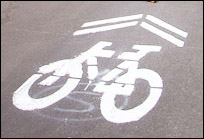 Bicycling to and from the Pigeon a few days ago, I rode a number of “facilities,” as bureaucrats like to call them: the marvelous new section of the Los Angeles River bikepath paralleling Riverside Drive from North Fig to Fletcher, the bike lanes on York, and the sharrows on Fountain in East Hollywood.
Bicycling to and from the Pigeon a few days ago, I rode a number of “facilities,” as bureaucrats like to call them: the marvelous new section of the Los Angeles River bikepath paralleling Riverside Drive from North Fig to Fletcher, the bike lanes on York, and the sharrows on Fountain in East Hollywood.
It was the sharrows that got me thinking more about connectivity. In part because they seem to be working: motorists leave more room when passing, and wait to pass without honking or shouting. But also because, like so much bicycle infrastructure in LA, they are just a fragment, not a network.
Now I know they are a “pilot project,” a test run. But there are plenty of other bits of long-extant bike lane, path, whatever all over the city that just start and stop without connecting to other “facilities.” It’s been a civic habit of ours.
If we were talking about separate bike paths or full-on bicycle boulevards (which we are talking about for certain streets), I could understand–but sharrows, lanes, and even road diets require nothing more than a few buckets of paint, a bit of courage, and the consideration to engage in a bit of outreach in the affected neighborhoods before you start.
There’s a wealth of information available now on the benefits of road diets and bike lanes, not only on neighborhood safety, but also on local commerce. (I’ll list some links below.)
But the sharrows on Fountain made me think of what an opportunity we missed to test not just the safety but the effectiveness of street treatments that support urban cycling.
For example, why don’t the sharrows on Fountain extend all the way from Van Ness Avenue to Sunset Boulevard, and then become bike lanes where Fountain widens and winds into Silverlake, changing into Hyperion as goes? Those lanes should continue at least to Rowena. I ride that particular distance regularly and always see a good number of cyclists on it, but usually the sort whose riding style connotes experience. How many of our less practiced or simply more timid brethren and sisthren might be riding there if it were a street that welcomes, rather than tolerates, cyclists?
Furthermore, this extension would also connect with another fragmentary bike lane, the mile or so of striping on Myra from Fountain to Santa Monica. These lanes would feed each other. Ridership would almost certainly increase, and the city could study not only safety but the synergistic effect of the connected networks we deserve.
Something to think about, what with the BPIT meetings starting up now. Connectivity, networks, comprehensive access to all parts of the city. It’s not just that we deserve this. It’s that it will make LA live again, after decades of social stagnation.
Links:
On Road Diets
On Bikes and Commerce
On Bikes and Development (by Josef!)